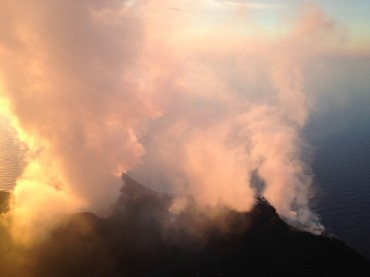
Columns of smoke above the crater in Stromboli Photo: Simon Fairbairn.
Elemental Conditions
Lecture by Josep Lluis Mateo
We are dealing with fire in a very specific spot: the island of Stromboli, Europe’s last permanently active volcano. Here, we are going to relate to fire in three ways.
First, as a physical presence, as a phenomenon that can be intellectually analysed or sensually perceived. Through sight, we can see its ascending flames; through the skin, we feel its warming heat; through the nose, we smell its gaseous fumes and, through the ears, we hear the volcano groan or breathe, almost like a living being. Here, then, fire presents a permanent, holistic atmosphere, a complex organological condition.
Second, as a kind of material basis, for the earth is the direct product of the volcano, a frozen fire. When you attach your building to the ground, the rock will be dried lava, and the dust, the volcano’s ashes. These things may not only be the support; they could also be the basic materials for building and imagining your structure.
Third, as a metaphorical connection with the sun, a permanent presence in the middle of the Mediterranean and a significant factor in the area’s mythological culture. Having pointed out the intrinsic relation with the earth and the sun, on Stromboli fire will interact forcefully with the other elements: the water that surrounds the island with its reflections, horizon, changing colour, surface and movement, and the air, since Stromboli is part of the Aeolian archipelago. Aeolus, as you all probably know, was the god of the wind; this is a very windy location, directly confronting us with another energy. So, we are presented synthetically with different primitive energies which, from the very start, defined the world and architecture from the roots, at origin.
Notes by Florian Sauter
Download article as PDFMore articles from Author
J. M. W. Turner: Lost Paradise – by Florian SauterMarina and Thermal Bath – by Josep Lluis Mateo, Anna Hotz, Cecilia Obiol, Florian Sauter & Ramias Steinemann Fusion of the Senses – Interview with Juhani Pallasmaa\"When you copy the things around you, you never become the center because you give up your own voice\" – Lecture by Li XiadongPragmatic, Poetic, Sacred – Lecture by Rahul MehrotraMeteorological Observatory – by Josep Lluis Mateo,Till von Mackensen, Chasper Schmidlin, Ramias Steinemann and Florian SauterPanta Rhei and Plato\'s Revenge – Lecture by Michael Hampe“Brazil is a place, where we can build buildings, which have the same air inside as outside“ – Lecture by Angelo BucciThe Shadows – Excerpts from Elias Canetti: The Tongue Set Free - Remembrance of a European ChildhoodHandmade? - or The Beauty of the Small – Lecture by Dagur EggertssonPedagogical Ambition – Lecture by Josep Lluis MateoINTERPRETATION CENTER: THE SCIENTIFIC KNOWLEDGE OF THE PHYSICAL AND CULTURAL LANDSCAPE – by Josep Lluis Mateo, Cecilia Obiol, Florian Sauter & Ramias Steinemann Natural Conditions: An Iconographical Survey of a Hotel Project in the Khor Al-Adaid Desert – by Josep Lluís Mateo, Krunoslav Ivanišin, Ramias Steinemann, Tomeu Ramis and Florian SauterGlobal Style – by Florian SauterAngelo Bucci (spbr) - Building the Americas – by Florian SauterSean Godsell - The Solid is the root of the Light; the Quiescent is the master of the Hasty – by Florian SauterText + Project – Interview with Pier Vittorio AureliTouching the Earth Lightly – Student: Sandro ElmerBreaking the Scale – Student Project: Xiong SunMore articles on topic
Journey into the Fire – Essay by Chasper Schmidlin, Video by Till von MackensenFire and Light – Interview with Stan AllenSTROMBOLI: MOUNTAIN OF FIRE IN THE SEA – by Ramias SteinemannA Guesthouse on Stromboli – by Josep Lluis Mateo, Anna Hotz, Till von Mackensen, Chasper Schmidlin, Ramias SteinemannJames Turrell: Skyspaces - Earthly Periscopes – by Till von MackensenVolcanoes – Lecture by Olivier Bachmann

